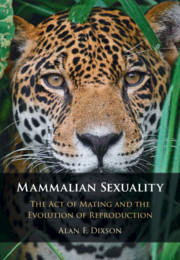Book contents
- Mammalian Sexuality
- Mammalian Sexuality
- Copyright page
- Dedication
- Contents
- Preface
- Acknowledgements
- Part I Carnival of the Animals
- Part II The Act of Mating
- Part III The Evolution of Reproduction
- 5 Phallic Structure and Function
- 6 The Testes and Spermatozoa
- 7 The Accessory Reproductive Glands and Ducts
- 8 Cooperation, Conflict and Cryptic Female Choice
- 9 The Evolution of Mating-induced and Spontaneous Ovulation
- Part IV Epilogue
- Book part
- References
- Index
9 - The Evolution of Mating-induced and Spontaneous Ovulation
from Part III - The Evolution of Reproduction
Published online by Cambridge University Press: 20 May 2021
- Mammalian Sexuality
- Mammalian Sexuality
- Copyright page
- Dedication
- Contents
- Preface
- Acknowledgements
- Part I Carnival of the Animals
- Part II The Act of Mating
- Part III The Evolution of Reproduction
- 5 Phallic Structure and Function
- 6 The Testes and Spermatozoa
- 7 The Accessory Reproductive Glands and Ducts
- 8 Cooperation, Conflict and Cryptic Female Choice
- 9 The Evolution of Mating-induced and Spontaneous Ovulation
- Part IV Epilogue
- Book part
- References
- Index
Summary
In most marsupials and placental mammals such as the primates, perissodactyls and elephants, as well as many rodents and artiodactyls, females ovulate ‘spontaneously’, meaning that ovulation proceeds in the absence of copulation. However, in certain species, such as rabbits, cats, and ferrets, stimulation provided by the male partner during mating is required to trigger the pre-ovulatory LH surge and thus to induce ovulation. Often, tactile stimulation during mating triggers ovulation, but in certain cases chemical cues, present in the semen, stimulate the LH surge. Examples of this latter type occur in members of the Family Camelidae, which includes the llamas and alpacas, as well as the dromedary and the bactrian camel.
- Type
- Chapter
- Information
- Mammalian SexualityThe Act of Mating and the Evolution of Reproduction, pp. 248 - 264Publisher: Cambridge University PressPrint publication year: 2021
- 1
- Cited by

